Remote Sensing-Based Mapping of Soil Health Descriptors Across Cyprus
Abstract
1. Introduction
2. Materials and Methods
2.1. Study Area and Soil Reference Data
2.2. Sentinel-2 Data Acquisition and Processing
2.2.1. Extraction of Sentinel-2 Predictors at Soil Sample Locations
2.2.2. Generation of Wall-to-Wall Predictor Raster for Mapping
2.2.3. Generation of Ancillary Environmental Layers
2.3. Soil Property Modeling
2.3.1. Data Preparation and Outlier Handling
2.3.2. Model Training and Cross-Validation
2.3.3. Accuracy Assessment Metrics
3. Results
4. Discussion
5. Implications, Caveats, and Future Work
- ➢
- Expand soil monitoring in areas identified as vulnerable to degradation, particularly in intensively cultivated zones.
- ➢
- Promote site-specific sustainable land management practices such as conservation tillage, organic amendments, and reduced input use.
- ➢
- Establish a centralized, harmonized national soil database to support long-term monitoring and integration with EU platforms.
- ➢
- Incorporate predictive soil maps into spatial planning, agri-environmental policy design, and restoration prioritization.
- ➢
- Integrate time-series Sentinel-2 data into future models to better account for temporal dynamics and climate-related shifts.
6. Conclusions
Author Contributions
Funding
Data Availability Statement
Acknowledgments
Conflicts of Interest
References
- Oishy, M.N.; Shemonty, N.A.; Fatema, S.I.; Mahbub, S.; Mim, E.L.; Hasan Raisa, M.B.; Anik, A.H. Unravelling the effects of climate change on the soil-plant-atmosphere interactions: A critical review. Soil Environ. Health 2025, 3, 100130. [Google Scholar] [CrossRef]
- Bilyera, N.; Turner, B.L.; Zhang, X.; Zang, H.; Dorodnikov, M.; Kuzyakov, Y. Soil Health Under Global Change and Human Impact. Land Degrad. Dev. 2025, 36, 683–688. [Google Scholar] [CrossRef]
- European Commission: Directorate-General for Research and Innovation; Veerman, C.; Pinto Correia, T.; Bastioli, C.; Biro, B.; Bouma, J.; Cienciala, E.; Emmett, B.; Frison, E.A.; Grand, A.; et al. Caring for Soil is Caring for Life—Ensure 75% of Soils are Healthy by 2030 for Food, People, Nature and Climate—Report of the Mission Board for Soil Health and Food; Publications Office: Luxembourg, 2020. [Google Scholar]
- Panagos, P.; Montanarella, L.; Barbero, M.; Schneegans, A.; Aguglia, L.; Jones, A. Soil priorities in the European Union. Geoderma Reg. 2022, 29, e00510. [Google Scholar] [CrossRef]
- Ronchi, S.; Salata, S.; Arcidiacono, A.; Piroli, E.; Montanarella, L. Policy instruments for soil protection among the EU member states: A comparative analysis. Land Use Policy 2019, 82, 763–780. [Google Scholar] [CrossRef]
- Broothaerts, N.; Breure, T.; Belitrandi, D.; Havenga, C.; Peeters, B.; Probst, C.; Barbero, M.; Panagos, P.; Jones, A. EU Soil Strategy Actions Tracker—A Tool to Track the Actions Listed in the EU Soil Strategy for 2030; Publications Office of the European Union: Luxembourg, 2025. [Google Scholar]
- Panagos, P.; Jones, A.; Lugato, E.; Ballabio, C. A Soil Monitoring Law for Europe. Glob. Chall. 2025, 9, 2400336. [Google Scholar] [CrossRef]
- Savarese, G.; Falconi, M. EU Soil Strategy for 2030: A Focus on Contaminated Sites and the Case of Italy. In Biodiversity Laws, Policies and Science in Europe, the United States and China; Antonelli, G., Qin, T., Ferroni, M.V., Erwin, A., Eds.; Springer Nature: Cham, Switzerland, 2024; pp. 151–170. [Google Scholar]
- European Environment Agency; Arias-Navarro, C.; Baritz, R.; Jones, A. The State of Soils in Europe—Fully Evidenced, Spatially Organised Assessment of the Pressures Driving Soil Degradation; Publications Office of the European Union: Luxembourg, 2024. [Google Scholar]
- Koumoulidis, D.; Varvaris, I.; Hadjimitsis, D.; Gabriele, M.; Brumana, R.; Gitas, I.; Georgopoulos, N.; Abdollahnejad, A.; Gkounti, E.; Stavrakoudis, D.; et al. Profiling Land Use Planning: Legislative Structures in Five European Nations. Land 2025, 14, 1261. [Google Scholar] [CrossRef]
- Prăvălie, R.; Borrelli, P.; Panagos, P.; Ballabio, C.; Lugato, E.; Chappell, A.; Miguez-Macho, G.; Maggi, F.; Peng, J.; Niculiță, M.; et al. A unifying modelling of multiple land degradation pathways in Europe. Nat. Commun. 2024, 15, 3862. [Google Scholar] [CrossRef]
- Bünemann, E.K.; Bongiorno, G.; Bai, Z.; Creamer, R.E.; De Deyn, G.; de Goede, R.; Fleskens, L.; Geissen, V.; Kuyper, T.W.; Mäder, P.; et al. Soil quality—A critical review. Soil Biol. Biochem. 2018, 120, 105–125. [Google Scholar] [CrossRef]
- Orgiazzi, A.; Ballabio, C.; Panagos, P.; Jones, A.; Fernández-Ugalde, O. LUCAS Soil, the largest expandable soil dataset for Europe: A review. Eur. J. Soil Sci. 2018, 69, 140–153. [Google Scholar] [CrossRef]
- Wangeci, A.; Adén, D.; Nikolajsen, T.; Greve, M.H.; Knadel, M. Comparing laser-induced breakdown spectroscopy and visible near-infrared spectroscopy for predicting soil properties: A pan-European study. Geoderma 2024, 444, 116865. [Google Scholar] [CrossRef]
- Panagos, P.; Broothaerts, N.; Ballabio, C.; Orgiazzi, A.; De Rosa, D.; Borrelli, P.; Liakos, L.; Vieira, D.; Van Eynde, E.; Arias Navarro, C.; et al. How the EU Soil Observatory is providing solid science for healthy soils. Eur. J. Soil Sci. 2024, 75, e13507. [Google Scholar] [CrossRef]
- Mäkipää, R.; Menichetti, L.; Martínez-García, E.; Törmänen, T.; Lehtonen, A. Is the organic carbon-to-clay ratio a reliable indicator of soil health? Geoderma 2024, 444, 116862. [Google Scholar] [CrossRef]
- Guo, M. Soil Health Assessment and Management: Recent Development in Science and Practices. Soil Syst. 2021, 5, 61. [Google Scholar] [CrossRef]
- Wood, S.A.; Bowman, M. Large-scale farmer-led experiment demonstrates positive impact of cover crops on multiple soil health indicators. Nat. Food 2021, 2, 97–103. [Google Scholar] [CrossRef]
- Zhang, J.; Dyck, M.; Quideau, S.A.; Norris, C.E. Assessment of soil health and identification of key soil health indicators for five long-term crop rotations with varying fertility management. Geoderma 2024, 443, 116836. [Google Scholar] [CrossRef]
- Cárceles Rodríguez, B.; Durán-Zuazo, V.H.; Soriano Rodríguez, M.; García-Tejero, I.F.; Gálvez Ruiz, B.; Cuadros Tavira, S. Conservation Agriculture as a Sustainable System for Soil Health: A Review. Soil Syst. 2022, 6, 87. [Google Scholar] [CrossRef]
- Lu, H.; Chen, X.; Ma, K.; Zhou, S.; Yi, J.; Qi, Y.; Hao, J.; Chen, F.; Wen, X. Soil health assessment under different soil and irrigation types in the agro-pastoral ecotone of northern China. CATENA 2024, 235, 107655. [Google Scholar] [CrossRef]
- Efthimiou, N.; Giotis, T.; Ragkos, A. Applications for Non-Conventional Water Resources in the Mediterranean Basin: A Literature Review. Sustainability 2025, 17, 4964. [Google Scholar] [CrossRef]
- Chrysargyris, A.; Xylia, P.; Litskas, V.; Mandoulaki, A.; Antoniou, D.; Boyias, T.; Stavrinides, M.; Tzortzakis, N. Drought stress and soil management practices in grapevines in Cyprus under the threat of climate change. J. Water Clim. Change 2018, 9, 703–714. [Google Scholar] [CrossRef]
- Sharma, D.K.; Singh, A. Current Trends and Emerging Challenges in Sustainable Management of Salt-Affected Soils: A Critical Appraisal. In Bioremediation of Salt Affected Soils: An Indian Perspective; Arora, S., Singh, A.K., Singh, Y.P., Eds.; Springer International Publishing: Cham, Switzerland, 2017; pp. 1–40. [Google Scholar]
- Phinikettou, V.; Papamichael, I.; Voukkali, I.; Economou, F.; Golia, E.E.; Navarro-Pedreño, J.; Barceló, D.; Naddeo, V.; Inglezakis, V.; Zorpas, A.A. Micro plastics mapping in the agricultural sector of Cyprus. J. Environ. Manag. 2024, 370, 122414. [Google Scholar] [CrossRef]
- Koumoulidis, D.; Varvaris, I.; Pittaki, Z.; Hadjimitsis, D. Sewage Sludge in Agricultural Lands: The Legislative Framework in EU-28. Sustainability 2024, 16, 10946. [Google Scholar] [CrossRef]
- Dalias, P.; Omirou, M.; Neocleous, D. Dataset on topsoil fertility characteristics in Cyprus. Data Brief 2025, 60, 111584. [Google Scholar] [CrossRef]
- Camera, C.; Zomeni, Z.; Noller, J.S.; Zissimos, A.M.; Christoforou, I.C.; Bruggeman, A. A high resolution map of soil types and physical properties for Cyprus: A digital soil mapping optimization. Geoderma 2017, 285, 35–49. [Google Scholar] [CrossRef]
- Cristiano, B.; Panos, P.; Luca, M. Predicting soil organic carbon content in Cyprus using remote sensing and Earth observation data. In Proceedings of the SPIE–International Society for Optical Engineering, San Francisco, CA, USA, 22–26 June 2014; p. 92290F. [Google Scholar]
- Feeney, C.J.; Bentley, L.; De Rosa, D.; Panagos, P.; Emmett, B.A.; Thomas, A.; Robinson, D.A. Benchmarking soil organic carbon (SOC) concentration provides more robust soil health assessment than the SOC/clay ratio at European scale. Sci. Total Environ. 2024, 951, 175642. [Google Scholar] [CrossRef] [PubMed]
- Panagos, P.; De Rosa, D.; Liakos, L.; Labouyrie, M.; Borrelli, P.; Ballabio, C. Soil bulk density assessment in Europe. Agric. Ecosyst. Environ. 2024, 364, 108907. [Google Scholar] [CrossRef]
- Yuzugullu, O.; Fajraoui, N.; Don, A.; Liebisch, F. Satellite-based soil organic carbon mapping on European soils using available datasets and support sampling. Sci. Remote Sens. 2024, 9, 100118. [Google Scholar] [CrossRef]
- Tziolas, N.; Tsakiridis, N.; Chabrillat, S.; Demattê, J.A.M.; Ben-Dor, E.; Gholizadeh, A.; Zalidis, G.; van Wesemael, B. Earth Observation Data-Driven Cropland Soil Monitoring: A Review. Remote Sens. 2021, 13, 4439. [Google Scholar] [CrossRef]
- Diaz-Gonzalez, F.A.; Vuelvas, J.; Correa, C.A.; Vallejo, V.E.; Patino, D. Machine learning and remote sensing techniques applied to estimate soil indicators—Review. Ecol. Indic. 2022, 135, 108517. [Google Scholar] [CrossRef]
- Wang, J.; Zhen, J.; Hu, W.; Chen, S.; Lizaga, I.; Zeraatpisheh, M.; Yang, X. Remote sensing of soil degradation: Progress and perspective. Int. Soil Water Conserv. Res. 2023, 11, 429–454. [Google Scholar] [CrossRef]
- Andries, A.; Morse, S.; Murphy, R.J.; Lynch, J.; Mota, B.; Woolliams, E.R. Can Current Earth Observation Technologies Provide Useful Information on Soil Organic Carbon Stocks for Environmental Land Management Policy? Sustainability 2021, 13, 12074. [Google Scholar] [CrossRef]
- Andries, A.; Murphy, R.J.; Morse, S.; Lynch, J. Earth Observation for Monitoring, Reporting, and Verification within Environmental Land Management Policy. Sustainability 2021, 13, 9105. [Google Scholar] [CrossRef]
- Mitchell, E.; Naoya, T.; Liam, G.; Peter, G.; Ken, D.; Sahar, A.; Warwick, B.; Annette, C.; Aaron, S.; Richard, E.; et al. Making soil carbon credits work for climate change mitigation. Carbon Manag. 2024, 15, 2430780. [Google Scholar] [CrossRef]
- Ingram, J.; Maye, D.; Reed, M. Contestations in the emerging soil-based carbon economy: Towards a research agenda. Sustain. Sci. 2025, 20, 597–611. [Google Scholar] [CrossRef]
- Abdalqadir, M.; Hughes, D.; Rezaei Gomari, S.; Rafiq, U. A state of the art of review on factors affecting the enhanced weathering in agricultural soil: Strategies for carbon sequestration and climate mitigation. Environ. Sci. Pollut. Res. 2024, 31, 19047–19070. [Google Scholar] [CrossRef]
- Neophytides, S.P.; Eliades, M.; Mavrovouniotis, M.; Papoutsa, C.; Papadavid, G.; Hadjimitsis, D.G. Improved water resources management for smart farming: A case study for Cyprus. Sci. Rep. 2024, 14, 31751. [Google Scholar] [CrossRef]
- Mustapha, A.A.; Abdu, N.; Oyinlola, E.Y.; Nuhu, A.A. Evaluating Different Methods of Organic Carbon Estimation on Nigerian Savannah Soils. J. Soil Sci. Plant Nutr. 2023, 23, 790–800. [Google Scholar] [CrossRef]
- Aguirre, J. The Kjeldahl Method. In The Kjeldahl Method: 140 Years; Aguirre, J., Ed.; Springer Nature: Cham, Switzerland, 2023; pp. 53–78. [Google Scholar]
- United States; Department of Agriculture; Agricultural Research Administration. Soil Survey Manual. No. 18; Agricultural Research Administration, US Department of Agriculture: Washington, DC, USA, 1951. [Google Scholar]
- Sanchez, C.; Mena, F.; Charfuelan, M.; Nuske, M.; Dengel, A. Assessment of Sentinel-2 Spatial and Temporal Coverage Based on the Scene Classification Layer. In Proceedings of the IGARSS 2024–2024 IEEE International Geoscience and Remote Sensing Symposium, Athens, Greece, 7–12 July 2024; pp. 4099–4103. [Google Scholar]
- Cavalaris, C.; Megoudi, S.; Maxouri, M.; Anatolitis, K.; Sifakis, M.; Levizou, E.; Kyparissis, A. Modeling of Durum Wheat Yield Based on Sentinel-2 Imagery. Agronomy 2021, 11, 1486. [Google Scholar] [CrossRef]
- Nascimento, C.M.; de Sousa Mendes, W.; Quiñonez Silvero, N.E.; Poppiel, R.R.; Sayão, V.M.; Dotto, A.C.; Valadares dos Santos, N.; Accorsi Amorim, M.T.; Demattê, J.A.M. Soil degradation index developed by multitemporal remote sensing images, climate variables, terrain and soil atributes. J. Environ. Manag. 2021, 277, 111316. [Google Scholar] [CrossRef]
- Zhang, D.; Zhao, Y.; Qi, H.; Shan, L.; Chen, G.; Ning, T. Effects of Micro-Topography and Vegetation on Soil Moisture on Fixed Sand Dunes in Tengger Desert, China. Plants 2024, 13, 1571. [Google Scholar] [CrossRef]
- Vaudour, E.; Gholizadeh, A.; Castaldi, F.; Saberioon, M.; Borůvka, L.; Urbina-Salazar, D.; Fouad, Y.; Arrouays, D.; Richer-de-Forges, A.C.; Biney, J.; et al. Satellite Imagery to Map Topsoil Organic Carbon Content over Cultivated Areas: An Overview. Remote Sens. 2022, 14, 2917. [Google Scholar] [CrossRef]
- Pittaki-Chrysodonta, Z.; Hartemink, A.E.; Sanderman, J.; Ge, Y.; Huang, J. Evaluating three calibration transfer methods for predictions of soil properties using mid-infrared spectroscopy. Soil Sci. Soc. Am. J. 2021, 85, 501–519. [Google Scholar] [CrossRef]
- Kiani-Harchegani, M.; Talebi, A.; Asgari, E.; Rodrigo-Comino, J. Chapter 7—Topographical features and soil erosion processes. In Computers in Earth and Environmental Sciences; Pourghasemi, H.R., Ed.; Elsevier: Amsterdam, The Netherlands, 2022; pp. 117–126. [Google Scholar]
- Torabi Haghighi, A.; Darabi, H.; Karimidastenaei, Z.; Davudirad, A.A.; Rouzbeh, S.; Rahmati, O.; Sajedi-Hosseini, F.; Klöve, B. Land degradation risk mapping using topographic, human-induced, and geo-environmental variables and machine learning algorithms, for the Pole-Doab watershed, Iran. Environ. Earth Sci. 2020, 80, 1. [Google Scholar] [CrossRef]
- Bragin, N.Y. The Most Important Events of Geological Evolution of Cyprus in the Late Cretaceous. Stratigr. Geol. Correl. 2022, 30, S78–S95. [Google Scholar] [CrossRef]
- Ferreira, C.S.S.; Seifollahi-Aghmiuni, S.; Destouni, G.; Ghajarnia, N.; Kalantari, Z. Soil degradation in the European Mediterranean region: Processes, status and consequences. Sci. Total Environ. 2022, 805, 150106. [Google Scholar] [CrossRef]
- Bouharat, D.; El Youssefi, F.; Yahya, A.; El Khalifi, K.T. Challenges for Sustainable Water Resource Management: Irrigation, Salinity and Contamination. In The Olive Landscapes of the Mediterranean: Key Challenges and Opportunities for Their Sustainability in the Early XXIst Century; Muñoz-Rojas, J., García-Ruiz, R., Eds.; Springer Nature: Cham, Switzerland, 2024; pp. 457–466. [Google Scholar]
- Tiefenbacher, A.; Sandén, T.; Haslmayr, H.-P.; Miloczki, J.; Wenzel, W.; Spiegel, H. Optimizing Carbon Sequestration in Croplands: A Synthesis. Agronomy 2021, 11, 882. [Google Scholar] [CrossRef]
- Mavsar, S.; Grčman, H.; Turniški, R.; Mihelič, R. Organic carbon sequestration potential of Slovenian agricultural soil and the impact of management practices on SOC stock. Cogent Food Agric. 2025, 11, 2437574. [Google Scholar] [CrossRef]
- Xia, W.; Hu, C.; Shi, J.; Zhuang, S.; Lian, X.; Wang, R. Study on the Water and Fertilizer Demand Model for Facility Fruit and Vegetables in Desert and Gobi Regions. In New Technologies Applied in Gobi Desert Facility Agriculture: Sensing and Autonomous Techniques; Hu, C., Wang, L., Xing, J., Wang, X., Zhang, Z., Eds.; Springer Nature: Singapore, 2025; pp. 145–179. [Google Scholar]
- Klein-Raufhake, T.; Hölzel, N.; Schaper, J.J.; Hortmann, A.; Elmer, M.; Fornfeist, M.; Linnemann, B.; Meyer, M.; Rentemeister, K.; Santora, L.; et al. Severity of topsoil compaction controls the impact of skid trails on soil ecological processes. J. Appl. Ecol. 2024, 61, 1817–1828. [Google Scholar] [CrossRef]
- Sadiq, M.; Rahim, N.; Tahir, M.M.; Shaheen, A.; Ran, F.; Chen, G.; Bai, X. Soil Bulk Density, Aggregates, Carbon Stabilization, Nutrients and Vegetation Traits as Affected by Manure Gradients Regimes Under Alpine Meadows of Qinghai–Tibetan Plateau Ecosystem. Plants 2025, 14, 1442. [Google Scholar] [CrossRef]
- Kaya, F.; Schillaci, C.; Keshavarzi, A.; Başayiğit, L. Predictive Mapping of Electrical Conductivity and Assessment of Soil Salinity in a Western Türkiye Alluvial Plain. Land 2022, 11, 2148. [Google Scholar] [CrossRef]
- Ondrasek, G.; Rengel, Z. Environmental salinization processes: Detection, implications & solutions. Sci. Total Environ. 2021, 754, 142432. [Google Scholar] [CrossRef]
- Ferreira, C.S.S.; Keesstra, S.; Destouni, G.; Solomun, M.K.; Kalantari, Z. Soil Degradation in the Mediterranean Region: Drivers and Future Trends. In Environmental Sustainability in the Mediterranean Region: Challenges and Solutions; Ferreira, C.S.S., Destouni, G., Kalantari, Z., Eds.; Springer International Publishing: Cham, Switzerland, 2024; pp. 81–112. [Google Scholar]
- Payab, A.H.; Türker, U. Resilience of rainfed agriculture in northern part of Cyprus: A comprehensive drought severity level impact analysis and adaptive strategies. Environ. Dev. Sustain. 2025, 27, 3033–3058. [Google Scholar] [CrossRef]
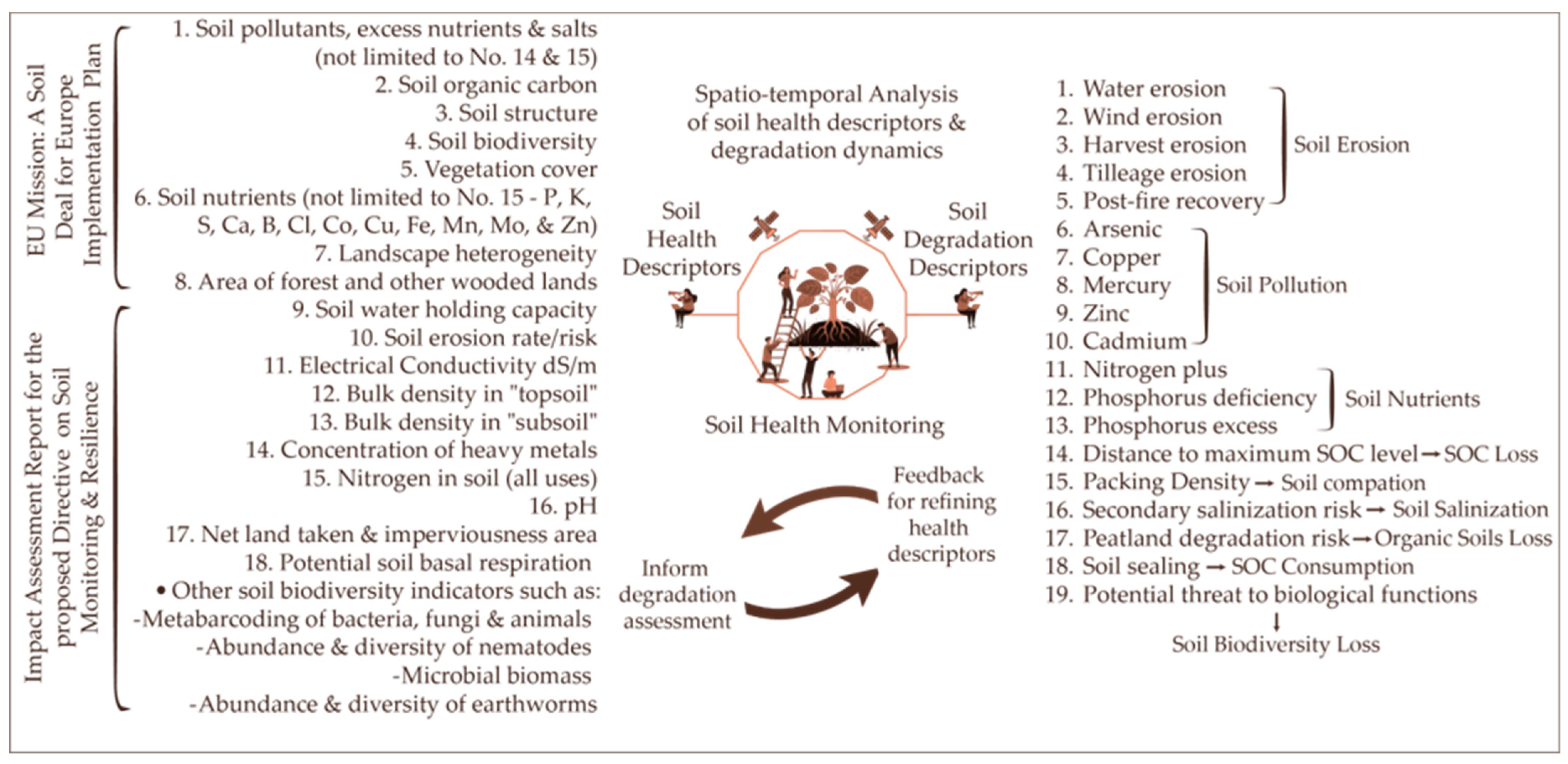
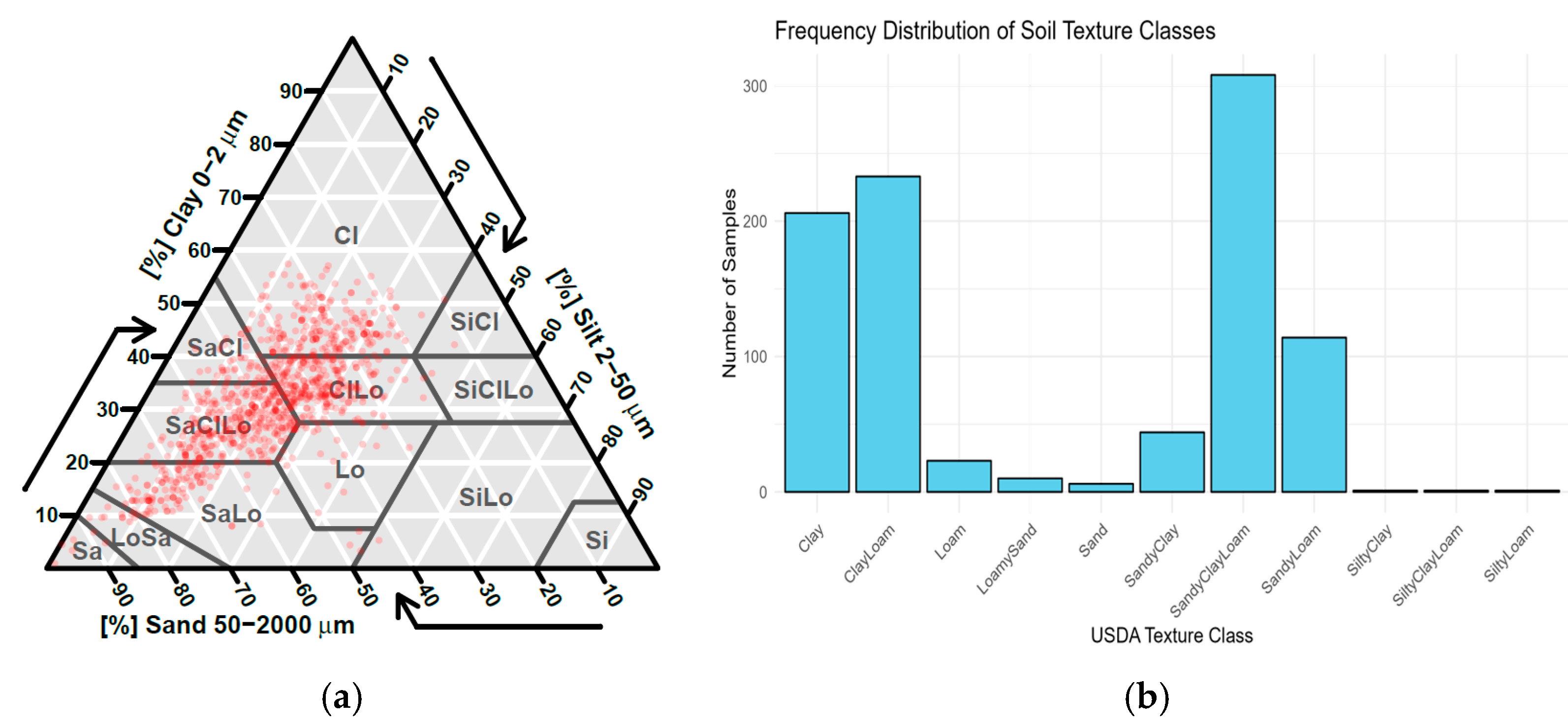



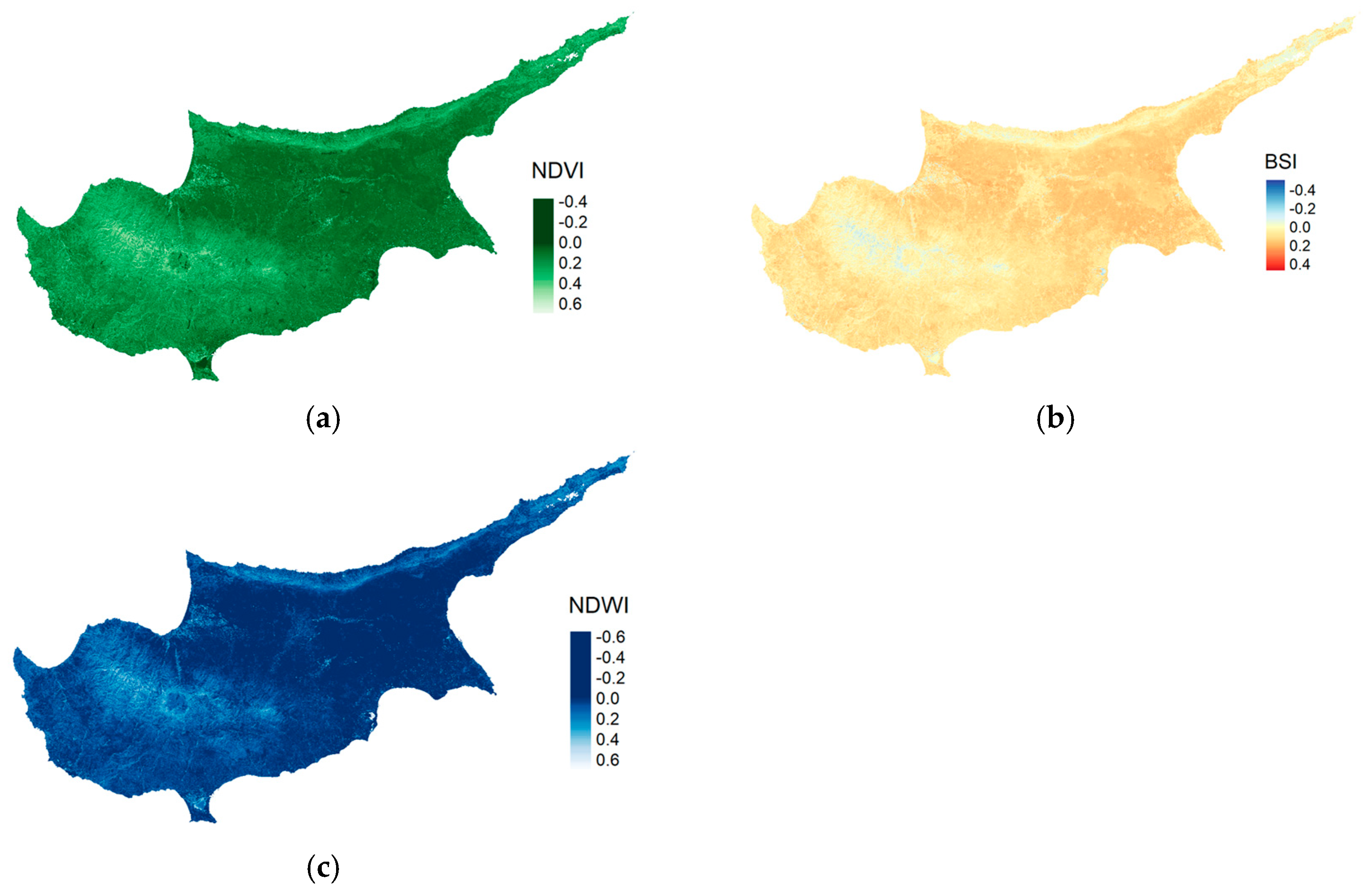
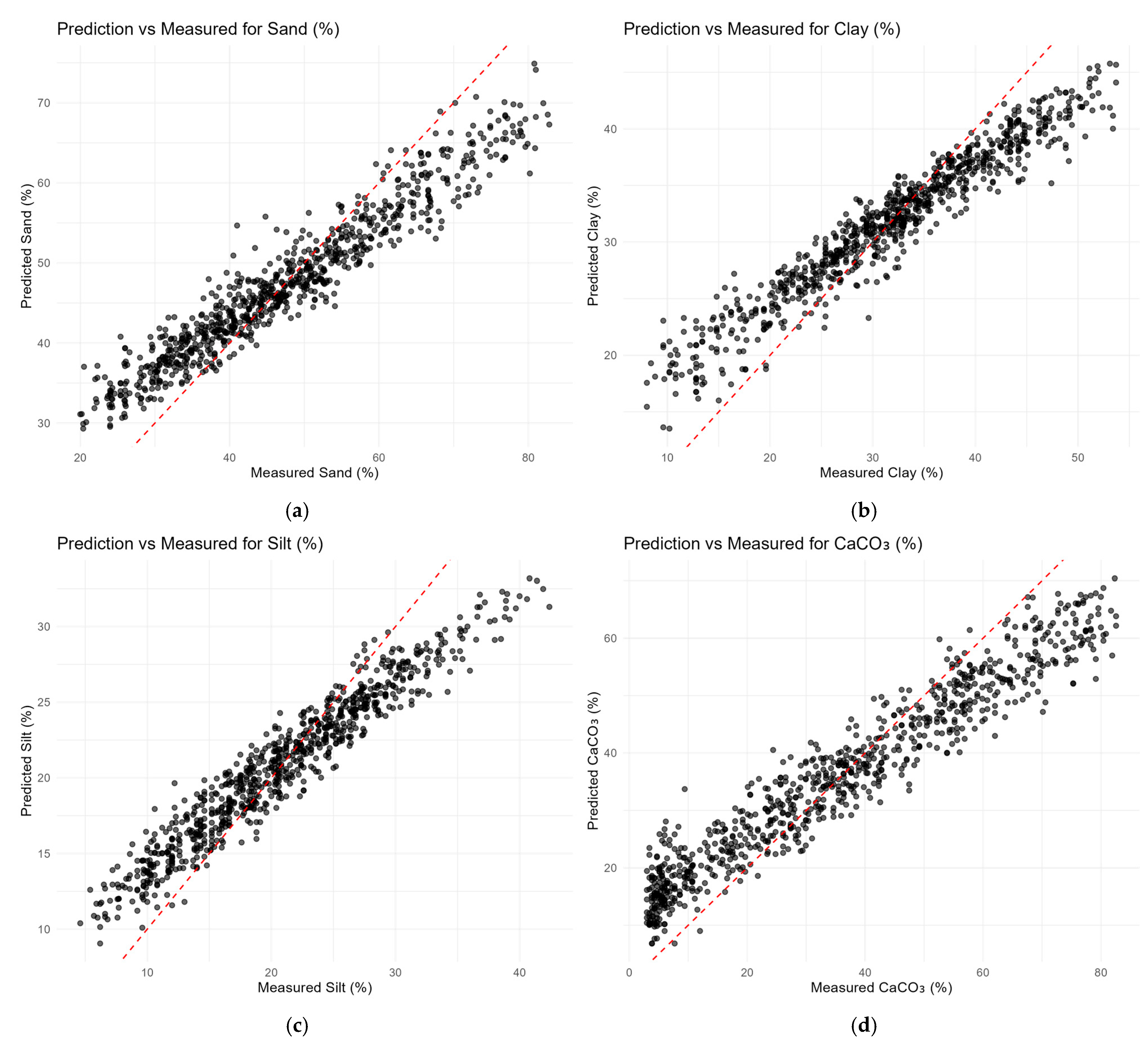

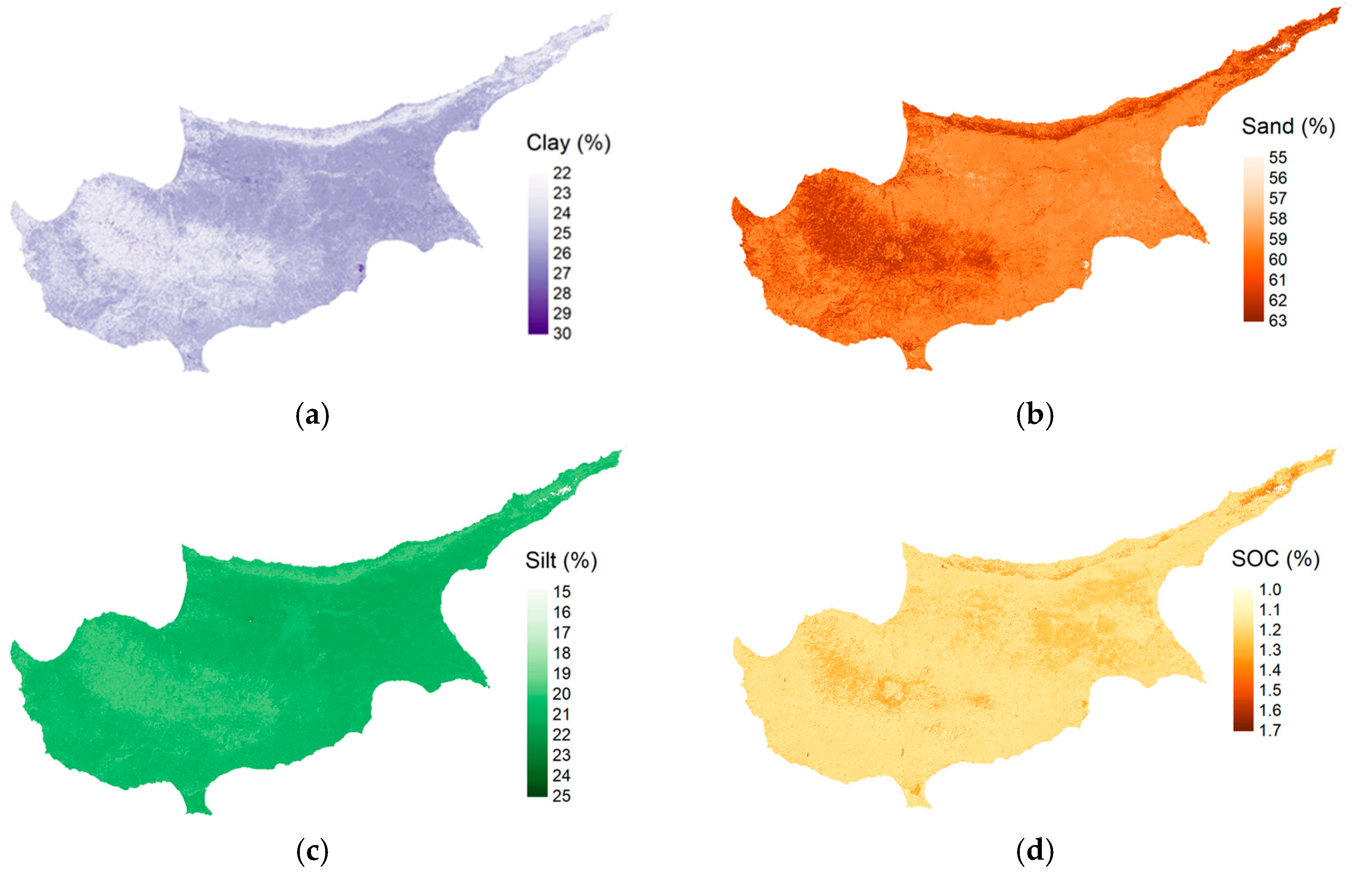
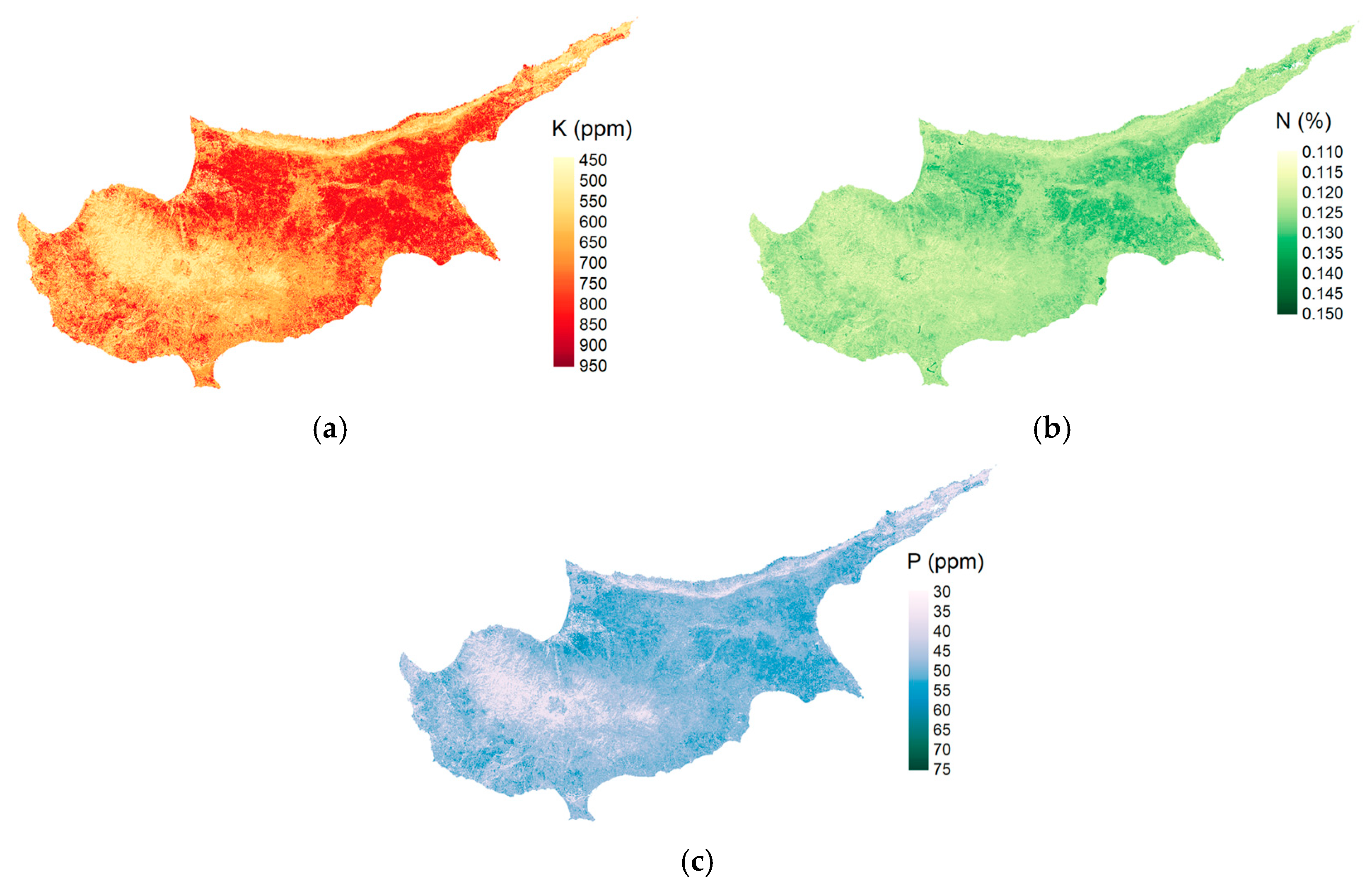

| Target | R2 | Concordance | MSE | RMSE | Bias | RPD | RPIQ |
|---|---|---|---|---|---|---|---|
| N (%) | 0.92 | 0.86 | 0 | 0.03 | 0 | 2.26 | 2.71 |
| P (ppm) | 0.92 | 0.84 | 202.34 | 14.23 | 0.51 | 2.18 | 1.91 |
| K (ppm) | 0.92 | 0.86 | 25,175.50 | 158.67 | 4.27 | 2.26 | 2.89 |
| pH | 0.92 | 0.88 | 0.02 | 0.12 | 0 | 2.39 | 2.82 |
| EC (dS/m) | 0.90 | 0.83 | 0.04 | 0.19 | 0.01 | 2.08 | 1.26 |
| CaCO3 (%) | 0.93 | 0.89 | 82.28 | 9.07 | 0.03 | 2.53 | 4.35 |
| Sand (%) | 0.92 | 0.87 | 36.17 | 6.01 | 0.06 | 2.38 | 3.43 |
| Silt (%) | 0.93 | 0.88 | 9.90 | 3.15 | −0.01 | 2.40 | 3.61 |
| Clay (%) | 0.93 | 0.87 | 18.86 | 4.34 | 0 | 2.34 | 3.22 |
| SOC (%) | 0.95 | 0.85 | 0.05 | 0.23 | 0 | 2.26 | 2.82 |
Disclaimer/Publisher’s Note: The statements, opinions and data contained in all publications are solely those of the individual author(s) and contributor(s) and not of MDPI and/or the editor(s). MDPI and/or the editor(s) disclaim responsibility for any injury to people or property resulting from any ideas, methods, instructions or products referred to in the content. |
© 2025 by the authors. Licensee MDPI, Basel, Switzerland. This article is an open access article distributed under the terms and conditions of the Creative Commons Attribution (CC BY) license (https://creativecommons.org/licenses/by/4.0/).
Share and Cite
Varvaris, I.; Pittaki, Z.; Themistokleous, G.; Koumoulidis, D.; Ouerfelli, D.; Eliades, M.; Themistocleous, K.; Hadjimitsis, D. Remote Sensing-Based Mapping of Soil Health Descriptors Across Cyprus. Environments 2025, 12, 283. https://doi.org/10.3390/environments12080283
Varvaris I, Pittaki Z, Themistokleous G, Koumoulidis D, Ouerfelli D, Eliades M, Themistocleous K, Hadjimitsis D. Remote Sensing-Based Mapping of Soil Health Descriptors Across Cyprus. Environments. 2025; 12(8):283. https://doi.org/10.3390/environments12080283
Chicago/Turabian StyleVarvaris, Ioannis, Zampela Pittaki, George Themistokleous, Dimitrios Koumoulidis, Dhouha Ouerfelli, Marinos Eliades, Kyriacos Themistocleous, and Diofantos Hadjimitsis. 2025. "Remote Sensing-Based Mapping of Soil Health Descriptors Across Cyprus" Environments 12, no. 8: 283. https://doi.org/10.3390/environments12080283
APA StyleVarvaris, I., Pittaki, Z., Themistokleous, G., Koumoulidis, D., Ouerfelli, D., Eliades, M., Themistocleous, K., & Hadjimitsis, D. (2025). Remote Sensing-Based Mapping of Soil Health Descriptors Across Cyprus. Environments, 12(8), 283. https://doi.org/10.3390/environments12080283









